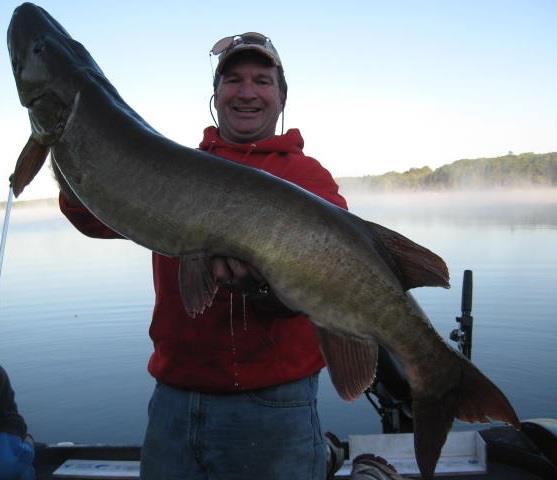|
|

Posts: 1460
Location: Kronenwetter, WI | I know alot of folks are onto this shrink-wrapping rear hooks on in-line spinners/topwaters...I'm not so sure that is the best way to go.
Think about it....when a fish has a hook in it and shakes its head...the more leverage it can generate when shaking increases its ability to move the hook OUT of its lodged location...thus more lost fish...
When there is a nice loose split ring allowing play between the hook and the bait, there is DECREASED ability to leverage the hook...Thus, less lost fish....
I realize the hook stands out straight when wrapped...and that supposedly increases hooking...but it also, in my opinion increases unhooking....finally, I'm not convinced that having a hook straight out really DOES increase hooking percentages....
Okay...chime in. |
|
| |
|
| It is just there to keep the rear hook from fouling up the spinning tail section. I wouldn't worry about the hookability with the shrink tubing, it flexes just fine when its hooked to a four footer.
|
|
| |
|

Posts: 2894
Location: Yahara River Chain | If it bothers you, a little jackknife will take care of it in short order. |
|
| |
|
Posts: 2089
| With some of the different materials used on "bucktails" today, shrink tubing the rear hook eliminates the hook fouling in the material. I've never had this problem/issue with regular bucktail, but rubber etc. can be a little tricky. Hope this helps. Steve |
|
| |
|

Posts: 1460
Location: Kronenwetter, WI | I've never had a problem running a bait w/o the tubing. I do get clients asking to have it put on baits I make them and I oblige, but...
Really---I never have seen the need for it. |
|
| |
|
| Cowboy,
I bought a ton of your bucktails this year and they do not have the shrink tubing on them.. I did not think it was a big deal till I listen to Luke Ronnstrand talk this year about a big fish he lost because he did not shrink tube his back hook on a cowgirl.. Basically he thought he was hooked up good, fighting the fish perfectly, than all of the sudden the fish let lose.. When the cowgirl floated to the surfact he noticed that when the fish crushed the lure, the back hook fouled with the front hook and did not allow him to get a good hook set.. This is only one instance, but if a person like Luke is going to make sure to make a point in one of his presentations that it is very important to shrink wrap your back hook, I am going to listen...It took me about an hour to shrink wrap the back hooks on the 12-15 bucktails I bought from you.. BTW.. the bucktails you made me are awsome!! |
|
| |
|
| Shrink tubing for me.
My hook-ups went way up when using shrink tubing vs. not.
I theorize that a couple of bad things can happen when using in-line baits w/out shrink tubing. First, in the course of a violent strike, the fish can move the (non-shrink tubed) hook out of position before the line ever tightens up for a hook-set. In other words, the hook can be swiveled completely forward, to the sides, or god knows what other strange angles by the momentum of the lunging fish just prior to the line tightening up. Guess how many fish we're going to catch when a non-shrink tubed hook is facing the wrong way just as we set the hook?
Granted this is more farfetched, I also wonder if the negative water pressure created by the rush of an open-mouthed musky from the rear of the bait may allow the (non-shrink tubed) hook to momentarily drop (even further), creating another poor angle when the line tightens for a hook-set.
Besides resolving Luke Ronnestrand's issue and preventing tangling with the dressing, a shrink-tubed hook would seem to be in a perfect hooking position more often than a hook that isn't shrink tubed - particularly in those cases when the momentum of the fish during the strike would have otherwised moved a hook out of position for a good hookset once the line eventually tightens up.
As luck goes, one of these two issues may be the reason I lose the biggest fish of my life, so I choose to eliminate the possibility by shrink tubing. I haven't seen any evidence that shrink tubing hooks on in-line baits allows greater leverage, resulting in more lost fish. The shrink tubing flexes and the bait is relatively light to begin with, so no worries there in my way of thinking.
Brian
|
|
| |
|
| If you're having fouling problems then there really isn't an option, shrink tube it. I see cowboys point but the thing bucktails have an advantage over other baits with that issue is weight. There might be some 'leverage' developed but the fish doesn't have the weight to toss around during head shakes. I don't think shrink tubing hurts anything and for some bucktails may reduce fouling which can be a killer. We're talking about percentages here and with this type of fishing and the numbers, it just doesn't seem like it adds up to a lot. But one fish to us may mean the same as catching 25 more walleyes to others! |
|
| |
|

Posts: 1460
Location: Kronenwetter, WI | Good thoughts.
Thanks,
Edited by Cowboyhannah 5/4/2007 5:07 PM
|
|
| |
 Whassup wth Shrink-Wrapping rear hooks?
Whassup wth Shrink-Wrapping rear hooks? Whassup wth Shrink-Wrapping rear hooks?
Whassup wth Shrink-Wrapping rear hooks?